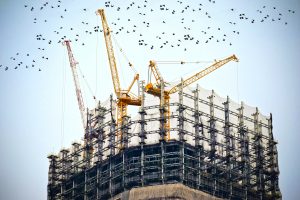Back

Blog
Revitalization of Birmingham, AL spurred by historic preservation
 An encouraging revitalization of Birmingham, Alabama is happening, spurred by an unintended consequence of industrial collapse. As in many other cities during the 1970s and ‘80s, industrial and manufacturing jobs moved out of the urban core and took residents along with them.
An encouraging revitalization of Birmingham, Alabama is happening, spurred by an unintended consequence of industrial collapse. As in many other cities during the 1970s and ‘80s, industrial and manufacturing jobs moved out of the urban core and took residents along with them.
Eager to revive local economies, many cities began altering their landscapes as a strategy for urban renewal. Buildings were torn down to make way for new condominiums and sleek offices spaces that would attract new residents and industries. However, Birmingham was unable to capitalize on these efforts, and its skyline and economy remained relatively unchanged. Over time, vacated warehouses began to deteriorate and crime proliferated throughout the downtown area.
In recent years, the city has started to create something remarkable out of its economic decline. Birmingham, “somehow escaped the failed urban renewal efforts that razed buildings of historical significance in other cities,” said Joe Gose of the New York Times. Now, “the district is home to an estimated 1.6 million square feet of largely vacant buildings constructed before World War II.”
Developers began seeing a unique opportunity in the city’s old buildings. “One of the great things about Birmingham not being as strong, economically, during the recent past is that [there wasn’t] a lot of wholesale demolition of our downtown,” explains David Fleming, CEO of REV Birmingham, a local organization that promotes downtown economic development.
Now, retaining downtown’s historic charm is a key piece of the city’s revitalization strategy. “Organizations such as mine have always made preservation a big part of our work. We want to bring in vibrancy by building open spaces and growing sustainable businesses,” Fleming said.
Government incentives have been critical to carrying out this economic development strategy, with most taking the form of historic tax credits. More than $240 million in state historic tax credits have been used to renovate Birmingham properties over the past decade. Many projects seek federal tax credits, as well. These tax credits have helped to restore dozens of buildings in downtown Birmingham, including:
- The Florentine Building: The two-story, 23,000 square foot building sates back to 1927 but is being reimagined as a restaurant, event space and catering company. Developers anticipate bringing at least 45 employees to the downtown through this project.
- The Redmont Hotel: A $20 million renovation is transforming the hotel into a 114-room boutique hotel. Developers are retaining the building’s historic look but adding a modern feel.
- The Thomas Jefferson Building: This 20-story hotel was the last to be built before the Great Depression. Ultimately, the hotel shuttered and the property had to be condemned by the City. Renovation of the building includes 100 apartments, 23,700 square feet of commercial space, a restaurant and a 14,000 square foot event space open to the general public. The developer has said the project wouldn’t have been feasible without historic tax credits filling a gap in financing.
- The Lyric Theater: The 1914 vaudeville venue had been closed since the late 1950s. In order to restore the building, asbestos and lead abatement was needed, among other building upgrades. Historic tax credits were used to offset the $11.6 million redevelopment price tag.
- The Powell School: The three-story building was constructed in 1888 and is being converted into 24 loft apartments.
Small businesses and creative workers are flocking to downtown’s authentic spaces—buildings that offer high ceilings, tall windows and industrial grit. Tech companies are starting to aggregate at the “Innovation Depot,” an entrepreneurial hub located downtown. Young professionals and empty nesters are moving into the industrial warehouses that have since been converted into lofts. Just last year, Thrillist named Birmingham’s Avondale neighborhood the “Brooklyn” of Alabama.
“People that don’t live here used to say with pride, ‘I haven’t been to downtown Birmingham for 10 or 15 years,’” explains John Lauriello, a principal at a property brokerage firm. “They wore it as a badge of honor.”
There’s more than local enthusiasm to suggest that using historic preservation as a catalyst for revitalization is working. Since 2000, downtown Birmingham has experienced an almost 40% residential growth. The number of 24-35 year olds living downtown has increased 58% between 2010 and 2014, which is more than triple the national average.
“The attitude shift, it’s like flipping a switch,” says Fleming. “It’s a huge change, especially with the younger generation.”
Despite this progress, many obstacles remain for Birmingham in coming years. Its 5.7% unemployment rate remains steadily above the national average, and the city also still struggles with a high crime rate that seems to be increasing. Adding to the complexity is the recent push from Alabama Senator Del Marsh to cease the historic tax credit program that has contributed to the bulk of Birmingham’s momentum. Part of his concern stems from the program’s impact on future state budgets because the tax credits can only be claimed after a project is complete. Up to $60 million has been reserved for ongoing projects, and Marsh is apprehensive that the budget will come under stress as claims roll in. He believes adding another $140 million to the credit pile will make things worse.
Despite these complications, there are many still working towards the stable vitality in Birmingham. Although major redevelopment projects will be difficult to complete without the historic tax credits, there are many – politicians, developers and historians alike – who oppose Marsh’s stance. The future of the tax credit program is uncertain, but Birmingham has already proven its ability to make strategic use of the tools available for revitalization and economic development.
